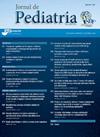根据控制血糖的治疗类型比较妊娠糖尿病妇女的围产期结局。
IF 2.8
4区 医学
Q1 PEDIATRICS
引用次数: 0
摘要
目的比较仅接受生活方式改变治疗的 GDM 孕妇与接受胰岛素和生活方式改变治疗的孕妇的围产期结局:前瞻性队列研究:对 64 名 GDM 孕妇进行产前和产后随访,直至出院,分为对照组(43 人)和胰岛素组(21 人),收集社会人口学、临床、血糖控制和围产期结局数据。胎儿巨大儿(≥ 4 千克)或妊娠期巨大儿是研究的主要结果:结果:胰岛素组的孕前体重指数(31.2 ± 3.9 对 28.8 ± 5.5)、舒张压(75 ± 8.7 对 69 ± 6.9)和餐后血糖(136.6 对 115.4)分别高于对照组。对照组新生儿的平均体重为 3058 克,早产率为 11.6%,而胰岛素组新生儿的平均体重为 3203 克,早产率为 4.8%。大多数新生儿的体重符合其胎龄。即使所有参与者都达到了血糖目标,但胰岛素组新生儿在第 5 分钟的阿普加评分和纯母乳喂养率较低,复苏率为 100%,住院时间较长:这些数据进一步说明,即使在改变生活方式的产前护理期间,使用胰岛素治疗 GDM 妇女的新生儿的预后也较差,包括临床并发症和纯母乳喂养率较低。在产前护理中,识别有风险的新生儿以采取预防和促进健康的措施非常重要。本文章由计算机程序翻译,如有差异,请以英文原文为准。
Comparison of perinatal outcomes of women with gestational diabetes mellitus according to type of treatment for glycemic control
Objective
To compare the perinatal outcomes of women with Gestational Diabetes Mellitus (GDM), between pregnant treated only with lifestyle changes and pregnant treated with insulin and lifestyle changes.
Methods
Prospective cohort study with follow-up of 64 women with GDM during the prenatal care and postpartum period until hospital discharge, divided into a control group (43) and an insulin group (21), with collection of sociodemographic, clinical, glycemic control and perinatal outcome data. Fetal macrosomia (≥ 4 Kg), or large-for-gestational-age newborns were considered the primary outcome of the research.
Results
Pre-pregnancy BMI (31.2 ± 3.9 versus 28.8 ± 5.5), diastolic blood pressure (75 ± 8.7 versus 69 ± 6.9) and postprandial blood glucose (136.6 versus 115.4) were higher in the insulin group, respectively. The control group had an average birth weight of 3058 g and an incidence of preterm birth of 11.6 %, while the insulin group had an average birth weight of 3203 g, with an incidence of preterm birth of 4.8 %. The majority of newborns had an adequate weight for their gestational age. Even all participants met glycemic goals, in the insulin group the Apgar score at the 5th minute and exclusive breastfeeding was lower, had 100 % of resuscitation cases, and a longer inpatient period.
Conclusion
These data reinforce that even during prenatal care with lifestyle changes, newborns of women with GDM treated with insulin had worse outcomes, including clinical complications and less exclusive breastfeeding. It is important in prenatal care to identify neonates with risk for prevention and health promotion measures.
求助全文
通过发布文献求助,成功后即可免费获取论文全文。
去求助
来源期刊

Jornal de pediatria
医学-小儿科
CiteScore
5.60
自引率
3.00%
发文量
93
审稿时长
43 days
期刊介绍:
Jornal de Pediatria is a bimonthly publication of the Brazilian Society of Pediatrics (Sociedade Brasileira de Pediatria, SBP). It has been published without interruption since 1934. Jornal de Pediatria publishes original articles and review articles covering various areas in the field of pediatrics. By publishing relevant scientific contributions, Jornal de Pediatria aims at improving the standards of pediatrics and of the healthcare provided for children and adolescents in general, as well to foster debate about health.
 求助内容:
求助内容: 应助结果提醒方式:
应助结果提醒方式:


